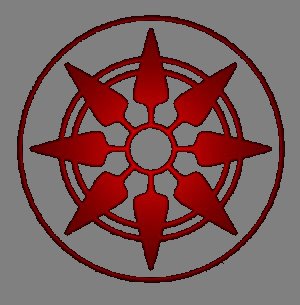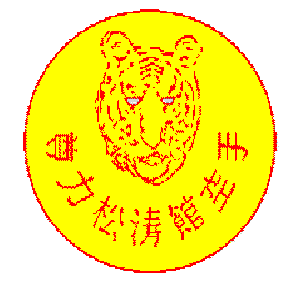
|
KEYWORTH
BUDOKAI
SONRIKI SHOTOKAN KARATE
KAI
KEYWORTH SHOTOKAN
KARATE CLUB
Keyworth, Nottingham
UK
Click on either
badge to return to home page
|
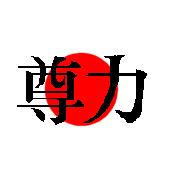
|
Click here to contact us
Click here for locality
map
Click on the Sonriki
icon  anywhere in the text to return to top
anywhere in the text to return to top

LEARN THE FASCINATING JAPANESE
MARTIAL ART OF TRADITIONAL SHOTOKAN KARATE WITH QUALIFIED BLACK BELT INSTRUCTORS.
THE ULTIMATE KEEP-FIT & SELF-DEFENCE
SYSTEM for MEN, WOMEN AND CHILDREN
personal security - self-confidence
- keep fit - self-esteem
|


KEYWORTH BUDOKAI
was established in Keyworth in 1985, and incorporates the
Keyworth Shotokan Karate Club. The Chief Instructor is
a black belt 5th Dan with more than 25 years experience of shotokan karate
as a student, instructor, competition referee and grading examiner.
The club is fortunate to be supported by a female black belt third dan senior
instructor, and several male black belt third dan senior instructors.
KEYWORTH BUDOKAI is an associate member of
Shi Kon Budokai
, which is affiliated to
Karate England
, the National Governing Body for Karate, recognised by
Sport England as the official body
representing karate in England.
The formal Japanese name of the club, SONRIKI  , means "noble strength", implying strength of mind and
body with respect and humility.
, means "noble strength", implying strength of mind and
body with respect and humility.
Karate is an excellent way of keeping physically and mentally fit,
and the ultimate system of unarmed self-defence. Karate teaches self-discipline,
leading to confidence and well-being. It can be practised by men and
women, boys and girls, young and not so young, and is therefore ideal for
all members of the family. SHOTOKAN
is the name of the style of karate practised - it is the most popular
style practised in the UK and Western Europe.
Keyworth Budokai Motto
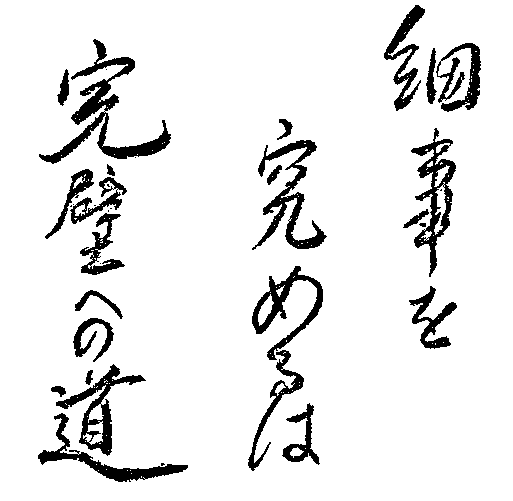
|
Saiji o kiwameru
wa kampeki e no michi
It is in mastering
details that one may reach perfection
|
Saiji
o
|
kiwameru
wa
|
kampeki
|
e
|
no
michi
|
|
Details
|
to
master
|
perfection
|
to
|
the
way
|
|
BELTS
Beginners start with a white belt (10th kyu), and then move on to red (9th
kyu), orange (8th), yellow (7th), green (6th), purple (5th), purple+white
stripe (4th), brown (3rd), brown+one white stripe (2nd), brown+2 white stripes
(1st), then black (1st dan). The first black belt grade (dan) is called
"shodan". "Sho" means "first" in the sense that something has happened
and will never happen again. Second dan (nidan) and higher grades use normal
counters (ni, san, yon, go, etc).


| |
CLUB SESSIONS
Click here for locality map
British Geological
Survey (gymnasium), Nicker Hill, Keyworth, Nottingham
EVERY MONDAY
ADULTS 7.00 pm - 9.00 pm
KARATE KIDS 7pm - 8pm - Age 8 & over
BEGINNER’S WELCOME AT ANY SESSION
EVERY THURSDAY
LUNCHTIME - 12 NOON - 1PM (BGS STAFF ONLY)
PRIVATE TRAINING
Chief Instructor George Strong Sensei 5th dan
is available for private training sessions or as an invited guest instructor
at other clubs. Contact
G Strong
for further information.
|


Membership is open to adults (men & women),
and children over 8 years old. For current training and membership
fees contact the Chief Instructor.
New membership includes Grading Record book and Association licence.
The optional Club Manual contains useful information, kata sheets, grading
syllabuses, karate dictionary etc., and is a recommended aid to training.
Grading Certificates can be kept in polypockets at the back.
Karate suits can be obtained through the club at discounted prices
- ask for order form.


Discipline is a very important part of training in any martial art.
Good discipline and correct etiquette encourage students and instructors
alike to give their best during training. Without discipline and mutual respect,
training would become meaningless. Respect and discipline should, of course,
extend beyond the dojo into our daily lives. We study a powerful and aggressive
art - thus self-discipline and humility must always overcome arrogance.
The rules of the dojo (training place) are based on traditional procedures,
but most are just common sense.
- 1. Every karateka must bow (rei) on entering or leaving the dojo.
It is not necessary to say 'oos'.
- 2. In the dojo, the senior instructor present must be addressed
as SENSEI (pronounced sen-say). Any other yudansha (black-belt) should be
addressed as SEMPAI (pronounced sem-pie, as in apple pie). If a visiting
instructor is teaching, he/she must be addressed as SENSEI, all other yudansha
as SEMPAI. Very high-grade instructors (usually 6th dan and above)
may be addressed as SHIHAN.
- 3. Normally all instructors, and especially visiting instructors
must be addressed as SENSEI both in and out of the dojo (e.g. in changing
rooms, discussions after training, in the street when meeting, even in the
pub after training!). Christian names may only be adopted outside the dojo
if the instructor has indicated that formalities may be dropped. These formalities
are waived by Keyworth Budokai instructors, but you should be aware
that they exist.
- 4. Every student should bow and say 'oos' to fellow students on
first meeting them in the dojo. It is the responsibility of the lower grade
to bow first. All students must bow to any black belt who enters the dojo
(unless the formal class has already started).
- 5. The dojo captain is the highest grade student in the dojo, excluding
the instructor. If formal bows from kneeling position (seiza) are taken before
and/or after training, the dojo captain should ensure that all lines are
straight, and say loudly 'SHORIN REI' when the sensei is facing away from
the class, and 'SENSEI REI' when the sensei faces the class. If there is
mokuso (meditation) during seiza, 'shorin rei' and 'sensei rei' are called
after 'mokuso yame' or 'matte' is called by the sensei.
- 6. There must be no smoking, eating or drinking in the dojo, nor
any bad language. There should be no noise or unnecessary talking.
- 7. Shoes should not normally be worn in the dojo. The dojo is not
the place for changing into karategi.
- 8. If a student has forgotten his/her belt, he must ask permission
from the sensei to train without a belt, or with the wrong colour belt.
- 9. Students arriving late must bow to the instructor and await invitation
to join in. It is customary to stand in musubi dachi (feet together, toes
out, formal stance) at the side of the dojo until you are invited to join
in. Do not disturb others if you have been given permission to join in during
an exercise. Do not disturb straight lines if the instructor is talking.
When joining the lines, take a position between students of your grade, and
the next grade down. The lower grades can then adjust the lines. Do not move
into the middle or head of your grade group.
- 10. It is the responsibility of the lower grades to make sure that
the dojo is fit to train in, i.e. tidy, clean floor, etc. If possible, chairs
should be made available for any spectators.
- 11. It is the responsibility of the Dojo Captain and other senior
grades to ensure that lines are straight before and after an exercise, and
that dojo discipline is maintained. Lines should normally be adjusted after
the bow at the end of an exercise.
- 12. Any students with a poor attendance record will not be permitted
to take their next grading examination. It is customary to inform the sensei
if you are likely to be absent for more than one or two sessions.
- 13. All students should learn the Japanese and English lines of
the 'Dojo Kun' ('Morals of the dojo). All lines begin with 'Hitotsu'. 'Hitotsu'
means 'first', or 'one', and thus all lines are of equal importance, but
the 'Dojo Kun' should be learnt and recited in the order given.


(Principles of the Dojo)
The Dojo Kun is traditionally recited at the end of each training
session. Normally the dojo captain recites one line loudly, and the rest
of the students repeat that line; then the captain recites the next line.
The English translations are not recited, but the students should try to
remember what each line means.
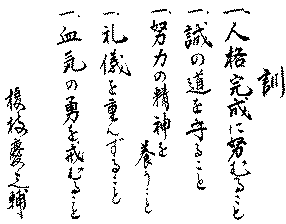
|
- Hitotsu! Jinkaku kansei ni tsutomuru koto!
- One! To strive for the
perfection of character
- Hitotsu! Makoto no michi o mamoru koto!
- One! To defend the paths
of truth!
- Hitotsu! Doryoku no seishin o yashinau koto!
- One! To foster the spirit
of effort!
- Hitotsu! Reigi o omonzuru koto!
- One! To honour the principles
of etiquette!
- Hitotsu! Kekki no yu o imashimuru koto!
- One! To guard against impetuous
courage!
|


There are three stages to master in any Budo. Sumo wrestlers
call them the 'Shin-gi-tai'. In karate-do it is the
same, but considered in reverse order as shin cannot be mastered
without gi, and gi cannot be mastered without tai
; and sometimes using the word waza instead of gi. Few
people master any of these; fewer still master all.
TAI (body)
WAZA or GI (technique)
SHIN (spirit) |
One must understand and
master the body
One must understand and master the techniques
One must understand and master the spirit |


CLICK HERE
TO CALCULATE YOUR BODY-MASS INDEX (BMI).
Use your BACK button to get back here.
Your
BMI is your weight (kg) divided by your height (m) squared. It should
be between 20 and 25. The calculator can use metric or imperial units. |


Please E-mail
any URL that should be added to this list.
 Back to top
Back to top
Back to Home Page
CONTACTS:
click here
|




